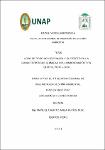Lodo de porcino y bovinaza y su efecto en la características químicas del lombricompost en Iquitos, Perú - 2020
Abstract
The research work was carried out at the National University of the Peruvian Amazon at the Faculty of Agronomy at the Cattle Workshop in the Zungarococha Farm, entitled SLUDGE OF PORCINE AND BOVINAZA AND ITS EFFECT ON THE CHEMICAL CHARACTERISTICS OF LOMBRICOMPOST IN IQUITOS, PERU - 2020. 3 Proportions of manure from
cattle, pigs and the combination of the previous two were used. The evaluations were carried out at three months, in wooden boxes 1m x 0.25 m x 0.25 m high, in plots of 0.5 m2 of area and 58.5 m2 of total area, which was under a roof with a cement floor. The statistical design used was a Completely Random Design (DCA), the treatments under study were: T1 (50kg / 0.5m2 bovine manure + 1000 adult worms), T2 (50kg / 0.5m2 of pig manure sludge + 1000 worms adult) and T3 (25kg / 0.5m2 bovine manure + 25 kilos of pig manure sludge + 1000 adult worms), obtaining the following results With T1 a pH of 8.16 was achieved, it was possible to increase the OM percentage (7.22 %). In the same way, Phosphorus (P) and Potassium (K), for Potassium (K), 208.25 ppm and T3 were obtained with values of 7.27 and 7.01 ppm, for the variables N and pH the non-parametric test of Kruskal Wallis was performed, due to the fact that the normality and homogeneity of pods was not fulfilled. Nitrogen N (%), with T1 and T3 values of 0.37% were found. El trabajo de investigación se realizó en la Universidad Nacional de la Amazonia Peruana en la Facultad de Agronomía en el Taller de Vacunos en el Fundo de Zungarococha, titulado LODO DE PORCINO Y BOVINAZA Y SU EFECTO EN LA CARACTERÍSTICAS QUÍMICAS DEL LOMBRICOMPOST EN IQUITOS, PERÚ – 2020. Se emplearon 3 Proporciones de estiércol de vacuno, porcino y la combinación de los dos anteriores. Las evaluaciones fueron realizadas a los tres meses, en cajas de madera de 1m x 0.25 m x 0.25 m de alto, en parcelas de 0.5 m2 de área y 58.5 m2 de área total, la que fue bajo techo con piso de cemento. El diseño estadístico utilizado fue un Diseño Completamente al Azar (D.C.A.), los tratamientos en estudio fueron: T1 (50kg/0.5m2 estiércol de Bovino + 1000 lombrices adultas), T2 (50kg/0.5m2 de lodo de estiércol de Porcino + 1000 lombrices adultas) y T3 (25kg/0.5m2 estiércol de bovino + 25 kilos de lodo de estiércol de porcino + 1000 lombrices adultas), obteniéndose los siguientes resultados Con el T1 se logró un pH de 8.16, se logró incrementar el porcentaje de MO (7.22 %). De igual manera el Fosforo (P) y Potasio (K), para el Potasio (K), se obtuvo 208.25 ppm y T3 con valores de 7.27 y 7.01 ppm, para las variables N y pH se realizó la prueba no paramétrica de Kruskal Wallis, debido a que no se cumplía con la normalidad y homogeneidad de vainazas. El nitrógeno N (%), con el T1 y T3 se encontró valores de 0.37 %.
Collections
- Tesis [498]


